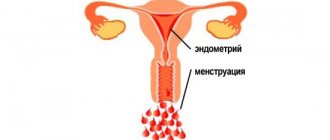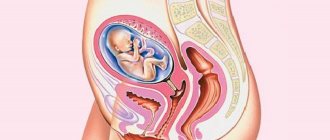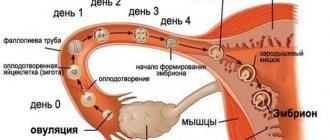Pregnancy is a time when a woman's body changes significantly. Some changes are obvious and understandable (for example, breast and abdominal enlargement), and some are not so much. For example, starting from the second half of pregnancy, the expectant mother begins to experience unpleasant sensations in the pubic area; over time, they can intensify so much that it becomes difficult for the woman to walk or sit. Where did these pains come from and what to do with them?
The woman’s pelvis is a ring and consists of several bones that are attached to the sacral spine at the back and connected at the front with the help of a fibrocartilaginous disc and ligaments. This connection is called the pubic joint (symphysis pubis), or symphysis , or pubis .
Usually the symphysis is in a stationary state, but during pregnancy it can diverge, because the pregnant woman’s pelvis becomes wider. The symphysis expands due to the fact that the ovaries and placenta synthesize a special substance - relaxin , which is able to relax the ligaments. Under its influence, the ligaments swell and become loose, as a result of which the joints become more mobile and the distance between them increases.
This is especially pronounced in the pubic symphysis; it is the one that diverges the most. This is a natural, physiological state that facilitates the birth process, because it will be easier for the baby to pass through a wide pelvis. After childbirth, when the level of hormones and relaxin returns to the pre-pregnancy state, all these changes disappear - the ligaments and joints become dense again.
What causes nagging pain in the lower abdomen during pregnancy?
Physiological reasons
Unpleasant sensations are natural in the early stages, since powerful hormonal changes are taking place, and the organs located in the pelvis are compressed and displaced. As a result, peristalsis is disrupted, intestinal colic and bloating appear.
Abdominal pain, like during menstruation, can occur at the very beginning of pregnancy, on the seventh day after conception. This means that the fertilized egg implants itself into the wall of the uterus.
Tugging sensations in different trimesters are caused by various physiological factors:
- sprain of the uterine ligaments;
- fetal growth and pressure on internal organs;
- training contractions.
If the condition does not worsen, there is no cause for concern.
Pathological causes
- Intense pain in the eighth week may be a sign of an ectopic pregnancy. It is accompanied by symptoms such as bleeding and a sharp deterioration in health.
- When your stomach feels tight during pregnancy, the threat of miscarriage cannot be ruled out. Signs of spontaneous abortion are pain in the form of contractions and spotting.
- Sometimes discomfort is caused by the child moving too actively. This is not always the norm: the fetus may suffer from oligohydramnios, lack of oxygen and other pathologies.
If pain and tingling in the lower abdomen are caused by complications during pregnancy, this always requires medical intervention, often emergency. Therefore, the expectant mother should be aware of the warning signs and be attentive to her condition.
Natural causes of abdominal pain when walking
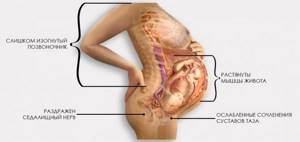
The uterus begins to enlarge almost immediately after conception, although it is still impossible to notice this with the naked eye. As the reproductive organ grows, the ligaments that hold it stretch. If a woman is not overtired, there is practically no discomfort. Minor nagging pain in the lower abdomen may occur after walking or excessive physical activity.
As the expectant mother's belly increases, her center of gravity changes. The musculoskeletal system experiences increased stress. This may be associated with heaviness in the lower abdomen when walking in the second trimester of pregnancy.
Changes in hormonal levels also matter. The body of the expectant mother begins to produce the hormone relaxin in increased quantities. It relaxes muscles and connective tissue. Thanks to this effect, the baby easily passes through the birth canal. In the last months of pregnancy, relaxin can provoke pain in the lower abdomen. Particularly unpleasant symptoms intensify after long walks.
The risk group includes representatives of the fairer sex who, even before pregnancy, had diseases of the musculoskeletal system. Almost all expectant mothers with scoliosis experience pain in the abdomen when walking. The pain increases in girls with osteochondrosis. A reduced level of calcium in the blood will also lead to pain, so from the first days of pregnancy it is worth consuming more fermented milk products.
How to get rid of pain
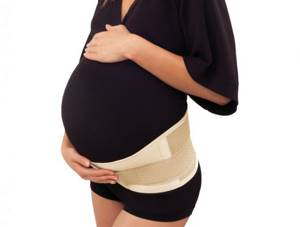
Prenatal bandage reduces the load on the pelvic bones
A woman needs to rest more, but lying on the couch for 9 months is not an option. A quiet rest should be alternated with short walks. Correct gait is of great importance. You need to pull your shoulders back and try not to slouch. Starting from the 20th week of pregnancy, you can use a special bandage that supports the abdomen. With its help, you will be able to get rid of tension in the spine and relieve stress from the abdominal muscles.
It is not recommended to use the bandage all the time. You need to put it on before walking outside or if you need to work on your feet.
Moderate physical activity will only benefit a pregnant woman. You can do special gymnastics aimed at training muscles. You also need to pay attention to nutrition. In addition to dairy products, your diet should include nuts, lean fish and meat, fresh vegetables and fruits.
How to distinguish between physiological and pathological pain?
Discomfort, which is associated with natural causes, does not increase and does not prevent a woman from leading a normal lifestyle. After taking an antispasmodic or resting in a horizontal position, the condition usually improves.
You should be wary if the pain becomes intense and takes on a cramping character. Dangerous symptoms include:
- bloody issues;
- general malaise;
- decreased blood pressure;
- cardiopalmus;
- pre-fainting state.
It is important to know that the condition when the stomach is pulled during pregnancy can be caused by non-obstetric reasons. Diseases of the gastrointestinal tract, urinary system, and surgical pathologies cannot be excluded.
Symptoms of symphysitis during pregnancy
Symphysitis usually manifests itself in the late stages of pregnancy - it happens already at the end of the second, but still more often in the third trimester of pregnancy - with its characteristic symptoms:
- severe swelling in the symphysis area;
- sensation of pain and characteristic clicks when pressing on the pubic bone;
- pain in the pelvis, pubic bone, groin, tailbone, thigh;
- sharp pain when changing the position of the body (rising, turning the body, getting up and when lying down);
- inability to raise straight legs while lying down;
- characteristic “duck” gait;
- walking in fractional, small steps;
- heaviness and pain when climbing stairs.
As the pathology develops, the pain intensifies, becomes more pronounced and can manifest itself not only when walking, but also in a passive state - in a sitting or lying position. Since X-rays are contraindicated during pregnancy, the doctor makes a diagnosis of symphysiopathy based on its described manifestations - according to his own observations and conclusions after examining his pregnant ward based on her complaints. You should not independently diagnose the development of symphysitis, since such pain during pregnancy can also be caused by other disorders, for example, changes in the femoral-sacral joints.
If symphysitis was diagnosed during pregnancy, then delivery by cesarean section is possible - there is a high risk of rupture during natural birth. When examining the patient, the doctor will certainly determine the degree of symphysitis and give prognoses for the future, as well as refer the woman for an additional ultrasound.
What to do if there is pain in the lower abdomen during pregnancy?
Only a doctor can find out the cause of discomfort. The Polyclinic+1 clinic has experienced gynecologists with extensive experience. They will examine you, clarify your complaints, refer you for tests, and, if necessary, for a consultation with a specialist. Based on the results of the examination, a gentle but effective treatment regimen will be drawn up.
If the cause of the pain is physiological, we will give recommendations on normalizing lifestyle and nutrition, and prescribe symptomatic therapy. In any case, you will get rid of fears about the fact that the lower abdomen pulls during pregnancy.
Symphysis during pregnancy
The long-awaited 28th week. During pregnancy, I suffered quite a few trials, for example, such as sensitivity, toxicosis up to 3 months of pregnancy, 2 times there was a threat of termination of pregnancy, and this whole difficult period happened to me in the first trimester of my pregnancy.
When everything was over, I felt much better... Another trip to the doctor, my tests were good. 28th week at night, as usual, I try to turn on the other side, and then I felt a sharp pain. At that moment, I thought that I made the wrong move, which is why it hurt so much. I soon realized that this was just the beginning...
The pain came to me every time I tried to change the position of my body at night. It was painful for me to turn on either side, and gradually it became painful for me to get up at night to go to the restroom. The pain was in the pubic bone area, my hips and even my legs hurt. I realized that something was wrong with me, and decided to use the description of all the signs to find the information I needed on the Internet. And I found very informative material about a diagnosis called symphysis.
As soon as pregnancy occurs, a woman’s body begins to prepare for the upcoming birth. Significant changes occur, in particular, in the symphysis, or pubic joint, a ligamentous-cartilaginous apparatus that connects both pubic bones of the female pelvis. Under the influence of hormonal changes that occur in the body of a pregnant woman, the ligaments of the symphysis pubis loosen, become saturated with tissue fluid, swell, and their extensibility increases. These changes are natural and physiological. They facilitate the passage of the fetus through the maternal pelvis and thereby contribute to a successful delivery. However, sometimes the ligaments are stretched too far and the symphysis relaxes excessively. Because of this, the ends of the pubic bones diverge, acquire some mobility and can shift in the vertical direction. Such phenomena make themselves felt by a dull pain in the pubis, which intensifies while walking and when changing body position. The gait becomes uncertain and swaying.
After 3 weeks, my gait changed greatly, the pain did not stop, and I went to the doctor who was managing my pregnancy. She also noticed that my gait had changed, I said that I suspected I had a symphysis. The doctor decided to check the condition of the symphysis, and we went to an orthopedist. The orthopedist felt me, asked me to stand up, sit down, walk around and lie down. He explained to me what a symphysis was, although at that time I already knew quite a bit about it.
The two halves that make up your pelvis are connected at the front by a rigid joint called the symphysis pubis. This joint is strengthened by a dense network of elastic, elastic ligaments. To help your baby move through the pelvic area as easily as possible, your body produces the hormone relaxin, which loosens the ligaments. As a result of the work of relaxin, these joints become more mobile during and immediately after pregnancy, which causes inflammation and pain. This is how the divergence of the pubic symphysis manifests itself.
A similar condition is called diastasis of the pubic symphysis. With it, the divergence of the pubic joint increases very quickly. The average distance between the bones of a non-pregnant woman is 4-5 mm. It is considered normal for pregnant women if this value increases by another 2-3 mm. If the distance between the bones is 10 mm or more, diastasis of the pubic symphysis is diagnosed. This happens quite rarely and can only be determined using x-rays or ultrasound.
We decided that instead of an x-ray we would do an ultrasound, since x-rays are not advisable during pregnancy due to their harm. Ultrasound revealed a discrepancy of 0.99 mm. Although, as far as I know, ultrasound does not show as accurately as x-rays, and the discrepancy could be greater. I was prescribed treatment. Because scientists do not agree on what causes symphysis pubis dehiscence, treatment may or may not work. In my case, I was prescribed to eat more calcium-containing foods, not lift objects heavier than 3-4 kg, be physically calm and eliminate stress.
Pain in the pubic and groin area is the most common symptom of symphysis pubis dehiscence. But you may also notice other signs: back pain, pelvic girdle pain, hip pain. Creaking or clicking in the pubic area. Drawing pain in the thigh or between the legs. The pain may worsen when spreading your legs, walking, walking up stairs in any direction, or when changing your sleeping position. The pain gets worse at night. It can interfere with your healthy sleep. Also, urination becomes especially painful at night.
The treatment didn't help. At 36 weeks it was painful for me to sit, stand up, turn around, go down and up stairs. At 37 weeks, doctors unanimously decided that a caesarean section should be performed as the pain was only getting worse. It didn’t make me feel better, I agreed to a caesarean section. They explained to me that if there is a rupture during childbirth, then for the first 2 months after birth I can lie on a hammock without moving.
In severe cases of damage to the symphysis pubis (rupture, severe sprain), as well as in the absence of effect from conservative treatment, surgical treatment is usually used using metal structures, the application of lavsan and wire sutures. Working capacity is restored only 3-4 months after the operation. After the caesarean section, the pain did not go away for about a month. After a month, the pain began to subside, and by 2 months the pain was completely gone.
I hope my experience will help you if you also encounter symphysis. Good luck and good health to all pregnant and postpartum mothers.
Burning in the stomach
A burning sensation in the stomach occurs for various reasons. It can be a consequence of diseases of the gastrointestinal tract, nervous, cardiovascular, genitourinary, respiratory systems, and skin diseases. A burning sensation in the abdominal area also occurs during pregnancy, due to the stretching of the skin by the enlarging uterus.
Burning in the upper abdomen
Most often, a burning sensation in the upper abdomen is a symptom of acute or chronic gastritis and is caused by an inflammatory process in the gastric mucosa. The burning sensation may be accompanied by pain in the epigastric region, a feeling of heaviness after eating, belching, heartburn, and nausea. Acute gastritis can occur when poisoned by poor-quality food, when caustic alkalis, acids and other irritating substances enter the stomach. Chronic gastritis is a long-term disease, the occurrence of which is associated with a number of reasons. Some of them are:
- poor diet and unhealthy foods;
- coffee, alcoholic drinks, strong tea;
- stressful situations;
- reduced immunity;
- smoking tobacco;
- infection with the bacterium Helikobakter pylori;
- medications.
A burning sensation in the upper abdomen can be caused by inflammation of the lower (abdominal) part of the esophagus - esophagitis. It can develop against the background of weakness of the lower esophageal sphincter, as a result of which acidic gastric contents are thrown into the esophagus, causing irritation and inflammation of its mucosa (reflux esophagitis). A burning sensation in the abdomen, accompanied by nausea, occurs with a diaphragmatic hernia, when the stomach protrudes through a hole in the diaphragm into the chest cavity, and the normal function of digestion is disrupted.
Other diseases of the gastrointestinal tract, such as peptic ulcers, cholecystitis, pancreatitis, and inflammation of the intestines, also sometimes cause a burning sensation. It is possible to find out which organ is affected only through examination by a doctor.
Also, a burning sensation in the upper abdomen can be a manifestation of diseases not related to the digestive system:
- pneumonia developing in the lower lobes of the lungs;
- pleurisy;
- acute myocardial infarction;
- dissecting aortic aneurysm.
These are serious diseases that require the mandatory participation of a doctor in their treatment.
Heartburn and burning also occur in late pregnancy, when the enlarged uterus puts pressure on the stomach, pushing it towards the diaphragm.
Burning in the lower abdomen
Burning and pain in this area can be caused by:
- appendicitis;
- ulcerative colitis, Crohn's disease;
- herpes zoster;
- cystitis, stones in the bladder and ureters;
- ectopic pregnancy or rupture of an ovarian follicle during ovulation and other reasons.
A burning sensation in the right lower abdomen may be one of the manifestations of appendicitis. Other symptoms are pain in this area, nausea, dry mouth, fever, abdominal wall tension, inflammatory changes in the blood test. In case of the slightest suspicion of appendicitis, you should immediately consult a doctor, without waiting until the appendix of the cecum ruptures, leading to life-threatening peritonitis.
With cystitis, accompanied by a burning sensation in the lower abdomen, frequent and painful urination is observed. We must not forget about irritable bowel syndrome, as well as the possibility of a psychogenic origin of such sensations, be it a burning sensation in the lower abdomen or in other parts of it. In order to confirm the psychogenic nature of the disease, it is necessary to exclude all possible organic causes.
Shingles
A burning sensation in the abdomen, both on the right and on the left, can be caused by herpetic ganglionitis, which is popularly called herpes zoster. When the herpes virus is activated, nerves anywhere in the body become inflamed, which is manifested by itching, unbearable burning and severe pain, which occurs a little later. After a few days, blistering rashes appear at the site of burning and pain. They pass exactly along the course of the inflamed nerve and are one-sided in nature, without crossing the midline of the body. Herpetic ganglionitis must be carefully treated, because... With insufficient treatment, severe pain and a burning sensation can bother you for years, very annoying and exhausting for a person.
In any case, if pain, burning, discomfort or any other unpleasant sensations appear in the abdomen, you must see a doctor who will conduct the necessary examinations, make a diagnosis, establish the cause of these symptoms, and prescribe adequate treatment.
womanadvice.ru
ticklish lower abdomen
BALL A round ball jumps without hesitation, jumps along the path Often, often, low, low from the hand to the ground so close Jump and jump and jump and jump, don’t jump to the ceiling, Jump and jump and knock and knock, you won’t escape our hands. (lightly and rhythmically pat along the back) FINGERS (1) Let’s begin our massage now, Let’s rub each finger: This one is the most beautiful of all, This one is the laziest of all, This finger is the longest of all, This finger is the smartest of all, (2) Together - this five friends (3) I want to stretch my fingers, I’ll twist each finger, This one is the most beautiful of all, This one is the laziest of all, etc. (4) We’ll take each finger and squeeze, squeeze, squeeze. This one is the most beautiful of all, etc. (5) We will take each finger, press on the pad This one is the most beautiful of all, etc. 1 - rub each finger, starting with the little finger, from the base of the finger to the tip 2 - stroke it immediately all fingers 3 - taking the finger by the tip and lifting it, carefully rotate it 4 - squeeze the fingers one by one in your fist 5 - press the tip of the index finger on the tip of the baby’s finger at the nail CABBAGE (1) We clean the cabbage, we clean it, we clean the cabbage, we clean it all Please don't yawn and help a little. (2) We chop the cabbage, chop it, we chop the cabbage, chop it. We ask everyone not to yawn and to help a little. (3) We are squashing the cabbage, squeezing it, we are squashing the cabbage, pressing it. We ask everyone not to yawn and to help a little. (4) We salt the cabbage, we salt it, we salt the cabbage, we salt it. We ask everyone not to yawn and to help a little. 1 - light sliding movements of all fingers, as if to tear the grass 2 - alternate tapping with the ribs of both palms 3 - press carefully with the palm with a slight rotation 4 - lightly tap with the tips of relaxed fingers HEDGEHOG (1) A prickly hedgehog is rolling, There is no head or legs, I don’t care *toes (up the leg/up the back) runs and puffs, puffs, puffs. Runs back and forth, I'm ticklish, yes, yes, yes! Go away, prickly hedgehog, into the dark forest where you live! 1 - roll a special rubber “hedgehog” for massage or gently tap with your nails BRIDGE (1) There is a narrow bridge over the river, there is no other way, Our animals decided to cross the bridge. (2) First, the cat deftly walked across the bridge, (3) Behind her, a snake crawled quietly on its belly. Behind her the snake crawled quietly on its belly. (4) The rooster marched behind her, as if in a parade... (5) Then the horned goat galloped twice, galloped twice. (6) Last, the duck waddled away, quacked, (7) Then the old woman came, took everyone home, took everyone home. 1 - stroke the back from bottom to top 2 - step the index and middle fingers of both hands along the back from bottom to top 3 - wavy movement of the palm placed on the edge along the back from bottom to top 4 - step to the music, leaning on your fingertips 5 - tap the back with your fists for each syllable from bottom to top, back and up again 6 - “go” with the palms of both hands 7 - “go” with the index and middle fingers, at the end of the song - tickle. HORSE (1) Here runs a horse, made of cotton wool, She doesn’t eat porridge, doesn’t drink milk, She just gallops back and forth, back and forth, back and forth. 1 - quickly tap with all fingers of one hand - “run to the music along the back and arms of the child FEATHER (1) Look, look what I brought! Look what a feather I found. It quietly crawls along the palm of your hand. First in a circle, and then forward. It crawls along the arm to the shoulder, and it very gently caresses the neck. Where it will fly is an interesting question. A feather landed on a small nose! Then the feather wants to stroke these ears, one and the other tickles a little, but now the feather needs to rest, it flies into the pocket to lie down. 1 - in accordance with the text of the song, touch the baby with a painted feather cut out of paper Beat flax, beat (knock on the back with our fists) Stoke, drown (rub with our palms) Beat, beat (pat) Crumpled, crushed (knead with our fingers) Trempled, shook (shake the shoulders) We wove white tablecloths (we draw with the edges of our palms) We set the tables (we stroke them with our palms) We chop, chop the cabbage (chopping movements with the edges of the palms) We rub, rub the carrots (rubbing movements with the knuckles) We salt the cabbage, salt (point touches with the fingers) We We squeeze the cabbage, we squeeze (squeezing the muscles with our fingers) We drink cabbage juice, we drink (stroking movements with our palms) (we rock the heel) Punch, bite, heel! Give me the shoe, grandma. If you don’t give me a shoe, we won’t forge a heel. A squirrel sits on a cart, (we stroke the heel in a circular motion) She distributes nuts to the thick-fifted bear - (we stroke the toes, starting with the big one) to the mustachioed little bunny - to the fox-sister-sparrow - to the titmouse, to whom in the mouth, (stroking the balls of the foot with the thumb) to whom in the goiter, "(we stroke the hand with the pen and further in the text) We will stroke the handle with the handle, we will rub the finger with the finger, we will rest just a little, and then we will start again Bird-bird, (we move the finger along the palm) Here is some water for you (make the same circle, but this time with the help of pinching) Here are the crumbs on my palm. Carcasses-tattoos, we baked cheesecakes (we move our hands up and down, like a musician playing the cymbals), placed them on the window (with a certain effort, our hands fall on our tummy) We left them to cool (we wave our hands) And the wheat pie - It is kneaded with maggots (gently pinch -knead from belly to shoulders) So high! (Hands rise to the top of the head) In the meadow, in the meadow (we stroke the tummy clockwise) There is a bowl of cottage cheese (we place our palm on the tummy), Two grouse flew in (we pinch the barrel from bottom to top) They pecked (we run two fingers over the tummy) They flew away (we stroke the baby) Chushki, views, perevyushki (we spin our little fists around each other) Timbirlim is sitting in a tub (we knock our fists against each other from the side of the ribs of our palms) And we are on the top of his head (we bring the baby’s hands closer to his head); Bam-bang-bang (we touch the head with our fists) Views, views, Views I view, I pound the beaters, I nail them down.
